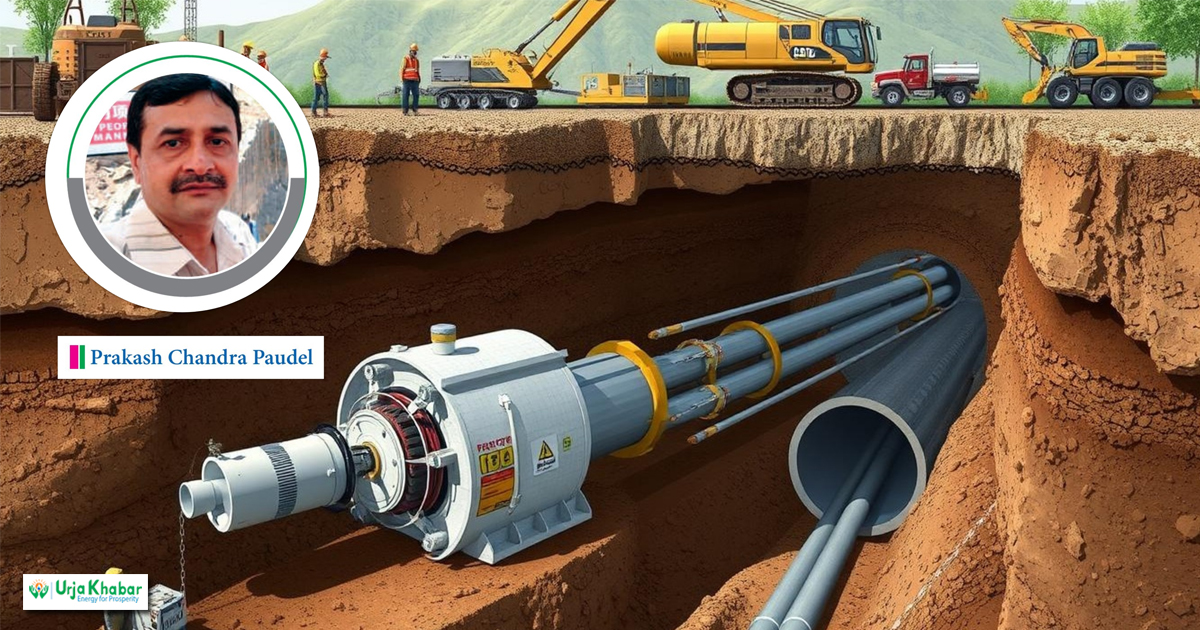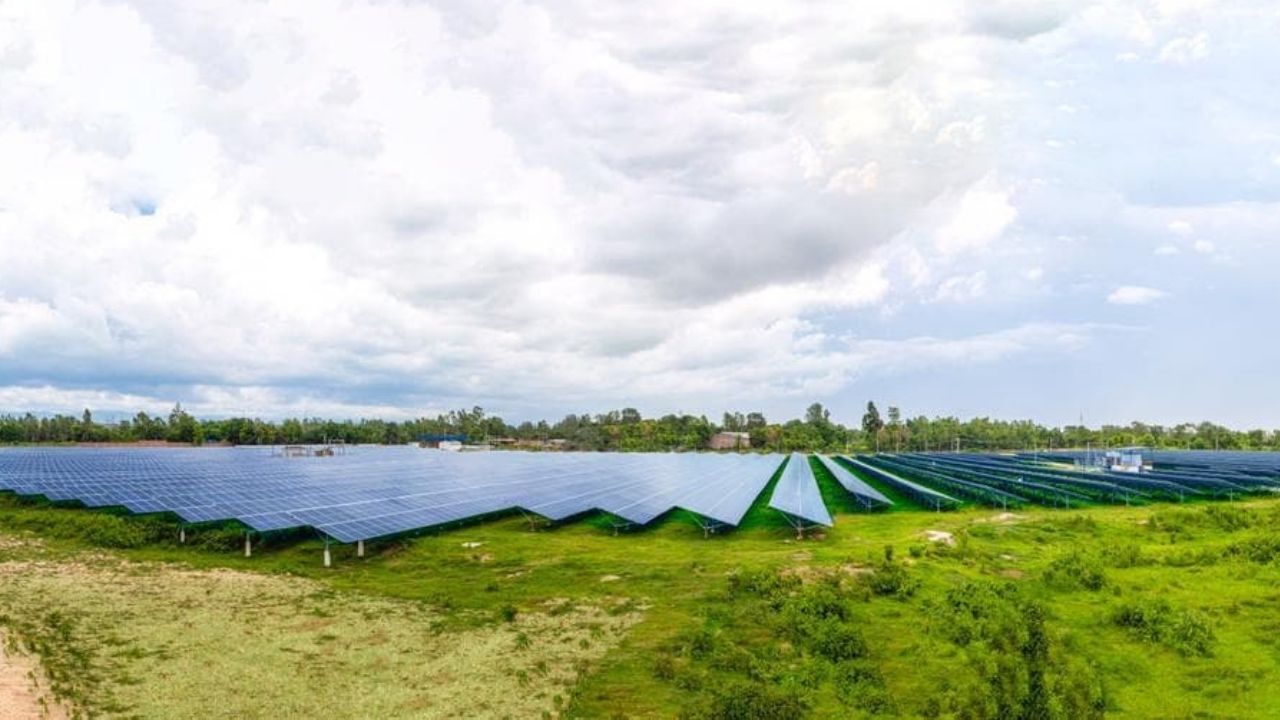Energy Update
From Watershed to Wattage: Unraveling Influences of Different Factors on Hydropower Generation in Nepal
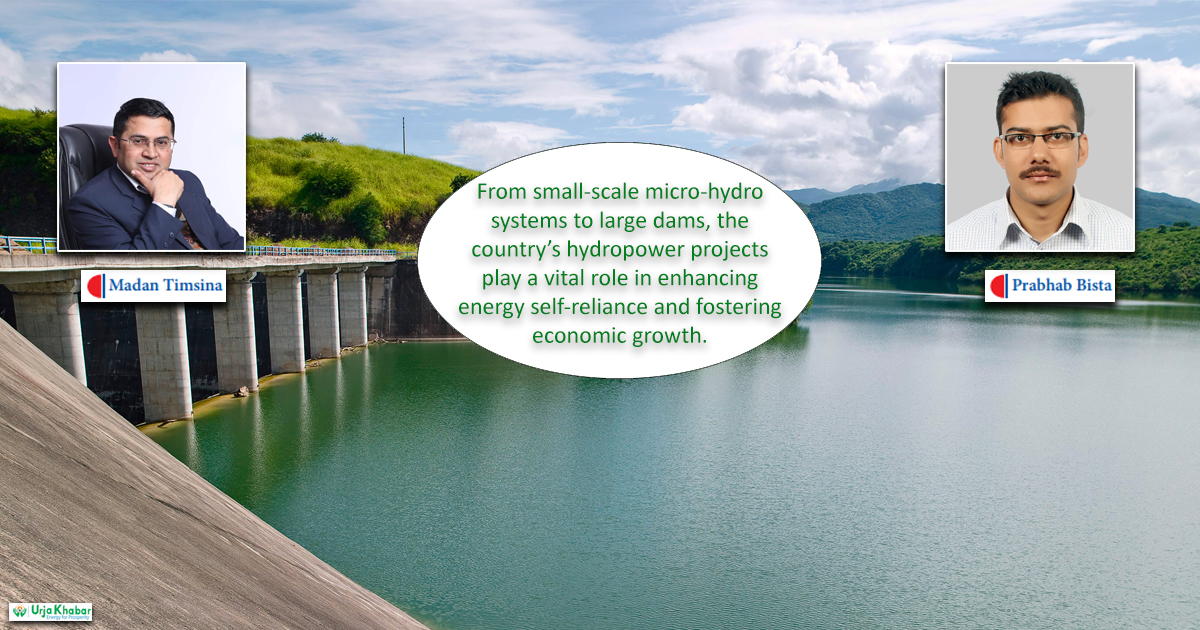
1. Introduction
Hydropower generation stands as a fundamental pillar of Nepal’s energy sector, leveraging its vast water resources to a remarkable extent. With an extensive network of rivers and challenging terrain, Nepal has one of the world’s most significant potentials for hydropower. From small-scale micro hydro systems to large dams, the country’s hydropower projects play a vital role in enhancing energy self-reliance and fostering economic growth.

According to a report of the NEA, Nepal’s total installed capacity, including hydropower plants, solar plants, diesel and bagas, reached 2829.99 MW (excluding micro hydro plants being generated by AEPC) by the end of Chaitra, 2080. However, operational capacity may vary due to certain plants being inactive at present. Despite surpassing the national peak load, recorded at 1986.39 MW (as per A Year in Review, 2022/23) in the last fiscal year, Nepal still imports power from India in dry seasons to meet its demand since the full installed capacity cannot be consistently realized throughout the year.
The article briefly explains the different influencing factors in power generation.

2. Generation Records
 The graph illustrates the electricity generation from NEA’s Hydropower plants over the past four years. The pattern reveals a consistent trend of reduced generation during the dry season and peak generation during the wet season. Interestingly, fluctuations in energy generation are evident within the same month across different years. This article aims to explore the various potential factors contributing to these fluctuations.
The graph illustrates the electricity generation from NEA’s Hydropower plants over the past four years. The pattern reveals a consistent trend of reduced generation during the dry season and peak generation during the wet season. Interestingly, fluctuations in energy generation are evident within the same month across different years. This article aims to explore the various potential factors contributing to these fluctuations.
3. Influences on Hydropower Generation
3.1 River Discharge
Seasonal variations in precipitation, snowmelt from the Himalayan glaciers, and monsoon patterns are the primary drivers of river discharge fluctuation in Nepal. The country experiences significant seasonal changes in river flow, with peak discharge levels observed during the monsoon season and reduced flow during the drier winter months. These fluctuations are directly impacted by variations in precipitation patterns, temperature fluctuations, and the dynamics of snowmelt in the Himalayan region.
3.2 Rainfall
Nepal undergoes a pronounced wet season, predominantly during the monsoon months from June to September. This period witnesses heavy rainfall, resulting in substantial rises in river discharge levels nationwide. Approximately 80% of Nepal’s annual rainfall is concentrated within this monsoon period. Consequently, most power plants operate at or near maximum capacity during these months. Nevertheless, the natural calamities associated with monsoon floods can occasionally disrupt the operation of certain power plants to some degree.
Upon comparing the seasonal generation of NEA hydro powerhouses with the seasonal accumulated rainfall data provided by DHM, several noteworthy trends emerge from the observed graphs.
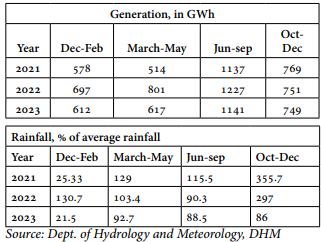 The graph depicting the generation pattern during the dry season illustrates a direct proportional relationship between energy generation and rainfall.
The graph depicting the generation pattern during the dry season illustrates a direct proportional relationship between energy generation and rainfall.
The proportial relation can be observed for the year 2022 and 2023. But, for the year 2021, the trend is just opposite. The reason behind the unusual trend for the year 2021 is rainfall below the average rate during most of the period of this season followed by over the average rate of rainfall during end of season. As the rainfall took place only during end of the season, the accumulated rain water became higher than average though the rivers suffered minimum discharge during most of the period in the season.
The graph above illustrates the post-monsoon season, which is typically the most favorable period for generating plants due to adequate river discharge and favorable water quality in terms of sediment content. In the year 2021, with accumulated rainfall reaching approximately 350% of the average, generation levels were notably high. The trend in generation closely mirrors the quantity of rainfall during this period.
3.3 Snow Melting
Nepal is home to a significant portion of the Himalayan mountain range, which contains vast glaciers. During the warmer months, particularly in spring and early summer, melting snow and glaciers contribute to increased river discharge levels as the water flows downstream into the rivers.
The man river basins in Nepal on which hydropower plants of NEA have been developed are Narayani, Karnali and Koshi basin having their sources in the snow andglaciers in the Himalayan region. Although permanent snow lies above 4570 m, glaciers come as low as 3000 m in some part of Nepal. Being the Himalayan snow and glaciers as the source of these rivers, the discharge in river is directly dependent on the temperature variation in different seasons.
The provided diagrams illustrate the variation in temperature across different regions of Nepal. During the winter months, a substantial area exhibits temperatures hovering around 0°C, indicating the presence of snow-covered regions. Conversely, in the summer months, these same areas experience temperatures around 9°C. This seasonal temperature variation reflects the dynamic climatic conditions present throughout Nepal, particularly in relation to the presence and melting of snow cover.
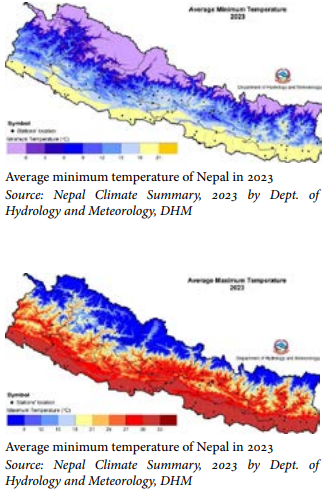 The parallel patterns of rainfall and temperature in Nepal dictate the seasonal cycles, with summers coinciding with the monsoon season and winters aligning with the dry period. This synchrony plays a pivotal role in shaping river discharge dynamics. During summer, elevated temperatures accelerate melting of snow on the Himalayas, enhancing river discharge alongside increased rainfall. Conversely, in the dry season, reduced rainfall coupled with cooler temperatures decelerates snow melting, leading to decreased river discharge. Thisinterplay between rainfall and temperature profoundly influences Nepal’s hydrological patterns.
The parallel patterns of rainfall and temperature in Nepal dictate the seasonal cycles, with summers coinciding with the monsoon season and winters aligning with the dry period. This synchrony plays a pivotal role in shaping river discharge dynamics. During summer, elevated temperatures accelerate melting of snow on the Himalayas, enhancing river discharge alongside increased rainfall. Conversely, in the dry season, reduced rainfall coupled with cooler temperatures decelerates snow melting, leading to decreased river discharge. Thisinterplay between rainfall and temperature profoundly influences Nepal’s hydrological patterns.
3.4 Maintenance Schedule
Maintenance of hydropower plants is essential to ensure the continuous and reliable generation of electricity. Maintenance of hydropower plants is a critical function that ensures the reliability, safety, and efficiency of electricity generation while also addressing environmental and regulatory requirements. By implementing comprehensive maintenance programs, hydropower plant operators can minimize risks, optimize performance, and contribute to the sustainable development of Nepal’s energy sector. The erosion in runners, corrosion in mechanical components due to continuous operation, contamination of lubricants, etc. demands periodic maintenance of the overall system.
The maintenance schedule of units or plants of hydropower station varies depending on their nature. Certain maintenance tasks necessitate a shutdown of the unit or plant, while others can be performed without any interruption to operations. For activities requiring a shutdown, the schedule is typically predetermined. It may occur either during the dry season when river discharge is minimal to prevent water spilling, or in the wet season when energy demand can be met by other plants. This strategic scheduling ensures that maintenance activities are conducted efficiently without compromising the overall power generation process.
Nepal’s initiation on cross-border electricity trading with neighboring India has addressed the issue of excess energy during the wet season to some extent. With the ability to export surplus energy, the problem of spillage during periods of high river discharge has been mitigated. Consequently, it is more advantageous for the NEA to operate its plants and export power rather than shutting down for repairs during the wet season. As a result, the NEA has adopted its strategy to conduct overhauls and maintenance activities on its machine units during the dry season. This approach minimizes the impact on overall energy generation and ensures optimal utilization of resources.
3.5 Generation Mix and System Management
The generation mix of Nepal is composed of mainly
a. Run-off-the River (RoR) plants (NEA and IPPs)
b. Peaking-RoR (PRoR) plants
c. Seasonal Storage Plants
d. Imports
The generation of Run-of-River (RoR) plants continues as long as the necessary discharge is available. This includes power generated from Independent Power Producer (IPP) plants, which is off taken on a take-or-pay basis. Since electricity cannot be stored, the system operator prioritizes the utilization of RoR plants from IPPs, RoR plants from NEA, and finally Storage plants, based on power demand. During periods of lower power demand, the system operator reserves PRoR and Storage plants for peaking times. This strategic management ensures efficient utilization of resources and optimal response to fluctuating power demand.
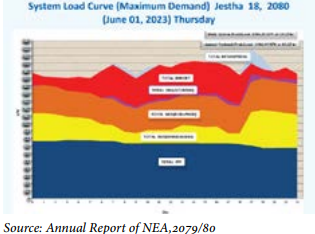 The provided figure depicts the month of June, characterized by abundant water availability. Consequently, most power plants operate at full capacity during this period. The base load is primarily supplied by IPPs’ power plants and NEA’s RoR and PRoR plants, while the daily fluctuations in power demand are managed by NEA subsidiaries, NEA storage, and total imports. This illustrates the established priority order for operating different types of power plants. Therefore, the operation and generation of power plants are also contingent upon the operational strategy of the system operator, Load Dispatch Center (LDC) in Nepal.
The provided figure depicts the month of June, characterized by abundant water availability. Consequently, most power plants operate at full capacity during this period. The base load is primarily supplied by IPPs’ power plants and NEA’s RoR and PRoR plants, while the daily fluctuations in power demand are managed by NEA subsidiaries, NEA storage, and total imports. This illustrates the established priority order for operating different types of power plants. Therefore, the operation and generation of power plants are also contingent upon the operational strategy of the system operator, Load Dispatch Center (LDC) in Nepal.
3.6 Environment Regulations
Environmental regulations and considerations, such as habitat protection, fish passage requirements, and water quality standards, can influence the operation of hydropower plants. Compliance with these regulations may require changes in operations that affect generation. The Hydro Power Development Policy of Nepal requires hydro companies to allow 10 percent of the minimum monthly discharge of the river to its natural course downstream of the dam. The provision though results minimal impact is wet season when there is enough water, it hampers generation during dry season.
3.7 Natural Calamities
As stated earlier, around 80% of annual rainfall occurs during monsoon season in Nepal. On top of that, hydropower plants and substations are made at river banks and directly linked with rivers and also, the transmission lines stretched over the difficult geographical terrain is always in risk of landslides and flood. During flood due to excessive rainfall, the plants are forced to shutdown.
Numerous instances of natural disasters, such as floods and landslides, have resulted in the destruction of headworks structures and powerhouses, as well as the collapse of transmission towers. One such incidentoccurred in mid-June 2021, when heavy rainfall triggered several landslides, causing Transmission Tower No. 9, a 132 kV structure, to collapse. As a result, complete power evacuation from Middle Marsyangdi HPS was halted for approximately 15 days until the erection of an Emergency Restoration System (ERS) Tower restored the power evacuation. Additionally, the flood forced the plant into a complete shutdown for three days, with several other plants also being shut down temporarily due to the adverse conditions. These events underscore the vulnerability of infrastructure to natural disasters and the consequential impact on power generation and transmission.
3.8 Sedimentations
Over time, reservoirs can accumulate sediment, reducing their storage capacity and potentially impacting power generation. Sediment management strategies may be necessary to maintain reservoir efficiency. Furthermore, a decrease in the efficiency of desander basins can lead to issues such as the choking of cooling mechanisms and erosion of turbine parts, resulting in disruptions to power generation. Data analysis has revealed sediment concentrations ranging from 300 to 11,000 parts per million (ppm) during the wet season, exceeding recommended limits for power plant operation. In such instances, power plants may be compelled to shut down operations. The high sediment load often leads to frequent filling of desander basins, necessitating frequent flushing requirements and subsequent plant shutdowns.
3.9 Water Management
The operating powerplants of the NEA also constitute power plants that are built under irrigation project, Gandak HPS, Chatara and Phewa HPS are among them. Gandak HPS, constructed under the Gandak Treaty between Nepal and India, aims the irrigation of some portions of both countries and basically canal management comes under jurisdiction of Department of Irrigation of respective states of India. Similarly, water management for Chatara HPS built under Sunsari Morang Irrigation Project is under control of Sunsari Morang Irrigation Project. The priority of the irrigation requirement drives the operating hours of the power plants. Hence, though the availability of water in the river, the plant remains ideal for a long time hampering the energy generation.
3.10 Climate Change
Nepal has historically made minimal contributions to global warming, yet finds itself among the most vulnerable nations to its effects. The country is witnessing accelerated snow melt in the Himalayas, alongside other consequences of climate change such as reduced agricultural productivity, flash floods, and landslides. Given that water is the primary resource for hydroelectricity generation, the disturbance to Nepal’s hydrological patterns due to climate change poses a substantial risk to hydroelectric projects. Consequently, the hydropower sector is exceptionally vulnerable to these climatic shifts. Moreover, hydroelectric projects, particularly large dam initiatives, come with significant environmental and social implications.
Hydropower plants being dependent on river discharge, the effect of climate change is a massive threat to it. The river discharge of snow and glacier based rivers is highly susceptible to temperature rise due to climate change.
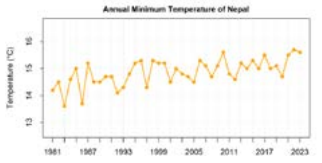 Annual average Minimum temperature of Nepal
Annual average Minimum temperature of Nepal
Source: Nepal Climate Summary, 2023 by Dept. of Hydrology and Meteorology, DHM
The depicted figure highlights the concerning trend of rising average minimum temperatures in Nepal over the past three decades. While this immediate increase may result in a temporary surge in river flow, the long-term implications suggest a potential decrease in river flow, ultimately affecting the generation capacity of power plants.
Conversation

ऊर्जा सम्बन्धी नेपालको पहिलो अनलाइन पत्रिका
- Info. Dept. Reg. No. : 254/073/74
- Telephone : +977-1-5321303
- Email : [email protected]












